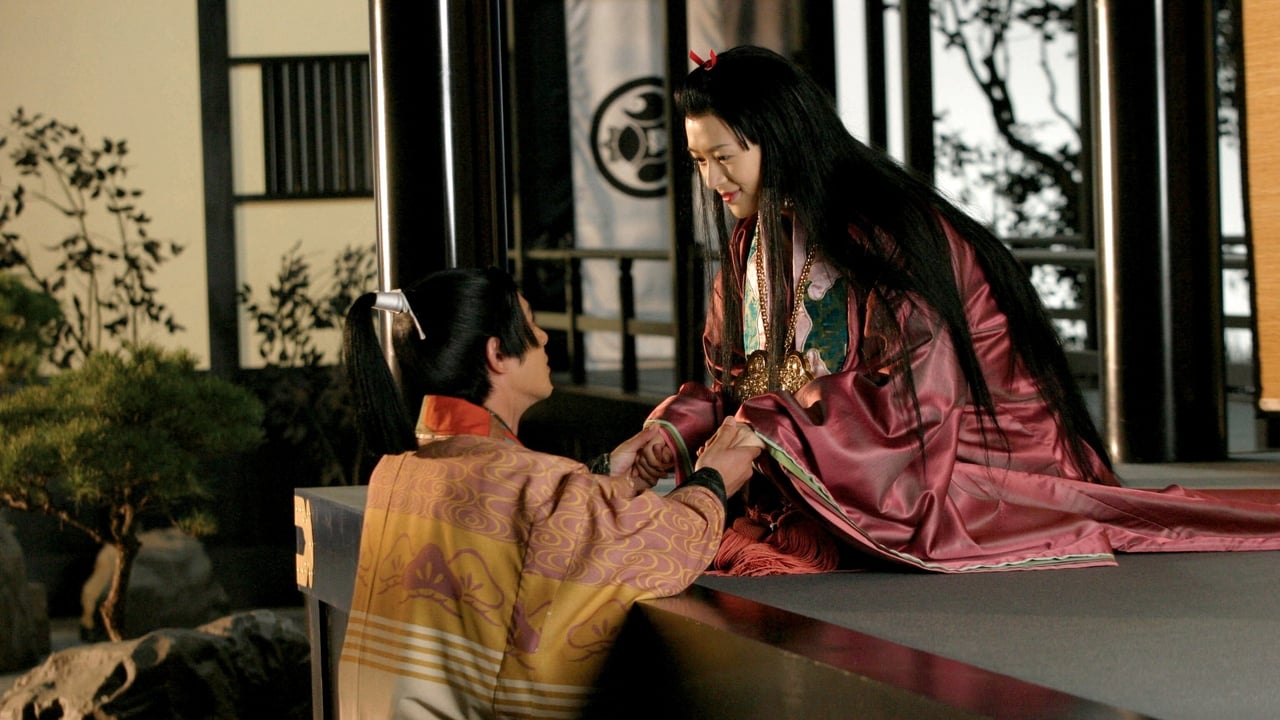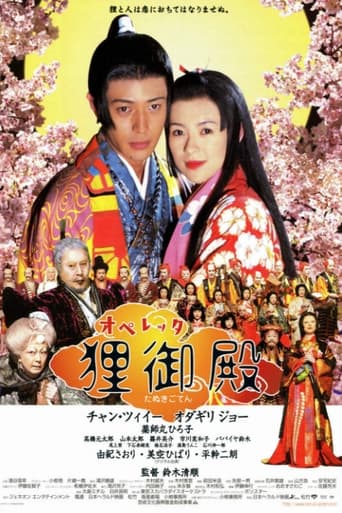

I think the problem with some reactions to this film is that they don't focus on its problem with deciding who it's really for, and what it's really about. On the we-like-it side, there are those who are taken in because it's CUUUUUTE. Sure it has very nice visual design, pretty costumes, and a variety of elements. Some children's movie fans love the colour and animation, and all the un-scary 'magical' effects, shapeshifting animals, and so on. Some culture vultures like the complicated references, the layerings of different folklore elements, and the fact that they can watch Zhang Ziyi singing and quasi-miming, in two different languages, in what really was intended to be a children's comedy. I hate to pop the balloon, but a hodgepodge of styles and references does not a movie make. (1) A children's movie should still have a point, (2) a blend of folktales is not the same as a coherent story, and (3) it's easier to believe in magic when enough thought and care has gone into the technical aspects to make it seem real.In other words, the ideas could be lovely; but when you put them onstage they have to deliver. Here, they don't.A good folktale - from any country - has a clear story, a point, and characters who interact strongly with each other. This picture lacks them all.As a fantasy fan, I must say that I've sat through some turkeys and loved a few, but this one really tries to do too many things - cheaply. The main problem isn't that there's no plot; there's half a plot, which means that you keep getting pulled in, then dropped again as another none-too-sharply-executed dance number kicks off. Putting in Zhang Ziyi to try to add a little glitter smacks of exotic flower syndrome. A few over-sophisticated gestures towards OPERA, Western and Japanese, are no replacement for a solid theme.The characters all seem to know that they're starring in a movie. Unless you really like watching other peoples' amateur video, this ain't good. I'd like to test this on real children; I think they'd drop it for Uproar in Heaven after about 20 minutes.
... View MorePartly inspired by the Tanukigoten musicals popular in Japan in the 1940's and 50's, maverick director Seijun Suzuki's as-yet final feature, Princess Raccoon (2005), is a deliriously abstract and stylised fantasy that mixes elements of philosophy and mysticism alongside an approach to film production that is incredibly theatrical in design. Beyond the look and feel of the film - which is really quite extraordinary from beginning to end - and the wider disregard for genre conventions and emphasis on visual storytelling, the narrative of Princess Raccoon is disarmingly simple; essentially dealing with the notions of betrayal and desire and the ultimate in forbidden love at its most fable-like and unrequited; with all of these contrasting ideas presented in an incredibly metaphorical sense, with the allusions to traditional Japanese folklore and certain ideas that would also inspire the underrated Isao Takahata film, Pom Poko (1994), produced by Studio Ghibli.Although this combination of influences and ideas might suggest an impenetrable work that requires a great deal of thought and consideration, the film is never heavy-handed or dense; with the themes being continually disguised by a veneer of colourful farce and giddy fantasy sequences that occasionally recall the style of classic cult TV series Monkey (aka Monkey Magic, or Saiyūki, as it was originally known), with the over-the-top characters, moments of kaleidoscopic colour and strange scenes of imaginative theatrical performance all captured against an artificial backdrop of stage design and lighting effects. It is typical of the defiant approach to cinematic rule-breaking and disregard for conventional storytelling that has been a highlight of Suzuki's work for the past forty-five years, as we see a complete symbiosis between the separate elements of the subject matter, and the self-conscious stylisation of the performances. Here, Suzuki really does indulge himself completely, drawing on elements of Noh theatre, Kabuki performance, Chinese scroll paintings and contemporary music videos, as he plays with a variety of sounds, images and musical motifs to create a jarring melange of ideas that underpin the thoughts and feelings of the two central characters.If you're unfamiliar with the director's work on iconic films like Gate of Flesh (1964), Tokyo Drifter (1966), Branded to Kill (1967) and the more recent Pistol Opera (2002), then you'll no doubt find much of the film a complete shock to the system; with the filmmaker's personal style, combined with the unapologetic reliance on Japanese cultural motifs that require a certain sense of familiarity with the subject, definitely causing a problem for many viewers unaccustomed to this particular stylistic approach. The style may also prove to be something of a barrier for anyone unable to look beyond the sense of camp and kitsch favoured by Suzuki in his vision of the film; with the opulent colour schemes, theatrical facade, blue screen projections, wire-work, musical numbers and action choreography becoming entirely self-indulgent, and yet, perfectly suited to the thematic concerns of the film. Again, such devises may seem jarring or needlessly ostentatious to audiences unfamiliar with the director's work, however, if you make the effort to meet the film halfway - disregarding the more obvious elements of purely nostalgic Japanese iconography and concentrating on the fun and frivolity of Suzuki's style and the deeper themes expressed through the characters - then the film pays off on a number of levels.Admittedly, there are still a few flaws; with elements of the story often grating and occasionally becoming hard to follow. There is also a downside to the film's emphasis on look and style - which eventually overwhelms us and causes us to lose sight of the more human element of the story within the scenes of outlandish, fantastical abstraction. Nonetheless, perseverance and a keen attention span will allow us to keep up with the film's jaw-dropping spectacle, and again, if we disregard the more purely Japanese elements of the script and focus on the central moral dilemma, then the film does work on a more immediate level. Unfortunately, judging from many of the other user comments, it would appear that some elements of the film were lost in translation. A real shame! Once again with Suzuki, the film exists, first and foremost, as a work of joyous, escapist entertainment; something that Princess Raccoon delivers in spades.
... View MoreI guess playing a Japanese character or acting in a Japanese movie doesn't warrant as much an uproar as having to play a Japanese geisha. And of course no prizes to be given out if you can guess why I would want to watch Princess Raccoon in the first place - that Zhang Ziyi is one of the leads in a Japanese movie, has piqued enough interest to pop the DVD into the player.The story is a simple one, which somewhat resembles that of Snow White. King Azuchi (Mikijiro Hira) is a terribly vain man, and like Snow White's evil stepmother, cannot stand for his offspring to be more beautiful (yes) than himself. So he hatches a plan to get rid of him, first by getting him murdered, failing which exile doesn't seem that bad of an alternative as well. So Prince Amechiyo (Jo Odagiri) accidentally journeys to the forbidden grounds at the foot of Mt Kairasu, where he meets with the Raccoon Princess Tanukihime (Zhang Ziyi), and thus it becomes a tale of forbidden love, as he's human, and she's obviously not, and goes through its Romeo and Juliet routines.But as it is, the plot is somewhat meandering and plodding. While its central structure is clear, it tangents off with a number of subplots, and unless you're in a mood for fantastical elements with magic, deities and all in various surreal scenes, you'll find the story going terribly all over the place. There are too many characters here, and most of them the minor ones that just chalk up the number of casts without adding much to the story, and there perhaps to boast the beautiful costumes.What takes the cake here is the gorgeous sets and special effects. For the most parts, watching the movie is like watching a stage play, in that the camera pretty much doesn't try anything fancy, nor break the invisible 180 degree rule. It's as if you're sitting in a theatre, and watching events unfold in pretty much the style of a stage musical built on intricately designed sets, with the multitude of songs and dances. What makes this movie unique is the visual presentation, fusing effortlessly the elements of computer generated graphics with live action (though some were deliberately cheesy), and that forms the primary appeal when watching the movie, which is part musical, part kabuki, part opera, nothing less than a visual spectacle.Zhang Ziyi obviously had her handicap in the movie worked to her advantage. Being a magical raccoon, she speaks in an incomprehensible language (which is Mandarin) to the rest of the Japanese folks, while being able to rote learn and spew by heart her lines in songs, given that they're repetitive in nature. Her acting's her a little over the top and exaggerated, perhaps to complement the operatic elements in the movie.Pick this up only if you are a completist in wanting to watch the movies in the filmography of Zhang Ziyi, or love graphics, sets and beautiful visuals. Otherwise the story is likely to bore you to death.
... View MoreWeird with unnecessary singing and backdrops. Randomly much of the action will occur on stage giving the feeling of an opera performance. None of that explains why this is such a bad film.It's the impression that either not enough rehearsal took place or that no experienced choreographer was available. The acting is flat. Even the sparkling Ziyi Zhang looks like she's just waiting for her next movement or line. You may notice the trivia on this site stating that she spent half a month in Japan learning to sign and dance. Read that again as 2 weeks and things begin to make sense. Even worse are the little kids who seem to be looking at their parents at the back of the studio rather than at the camera.The cheap and cheerful sfx are just cheap and cheap. The editing is staccato chops peppered with slices of just nothing that adds to anything except annoyance. Just imagine all the silly dance scenes from the recent Zatoichi - particularly the closing routine - performed by your local high school drama club with one famous actress who speaks in another language (but you get her in simply because she's so good normally despite being unsuitable), recorded on a cheap camera and then edited into three times its length in no artful order.
... View More